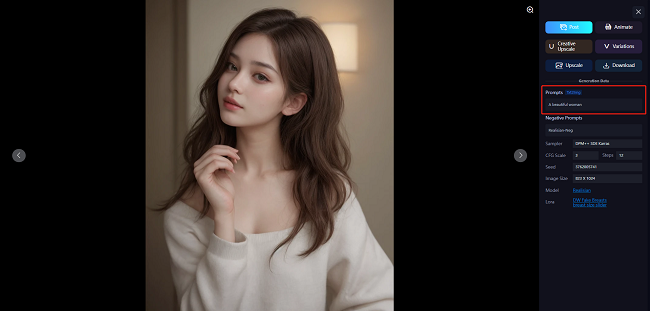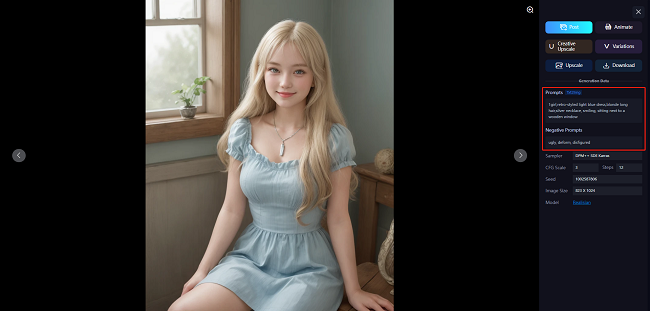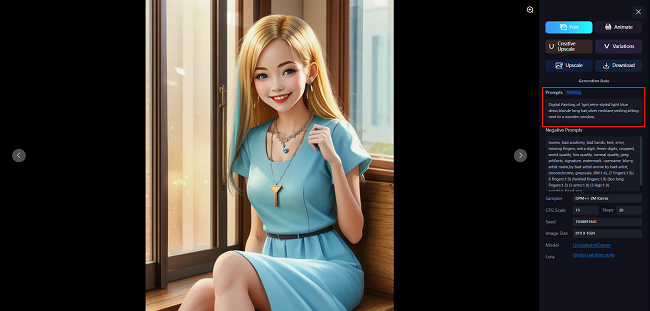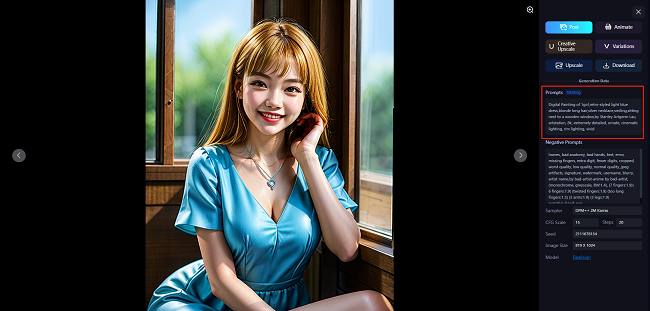
Master AI Image Prompts: Creating Beautiful AI Art
Have you ever been amazed by the stunning images generated by others using Stable Diffusion (SD) software? Even with the best SD tools, many people struggle to describe the images they want to create. Don't worry! This article will guide you step-by-step on how to generate beautiful AI images.
Follow me closely, and you won't get lost.
Preparation
First, you'll need Stable Diffusion powered software. You can use a local SD webUI or a cloud-based SD environment—both are fine. We'll use SeaArt AI as our example and create beautiful images step by step.
Effective AI Image Prompts
To construct an effective prompt that guides the generation model to produce your desired image, your prompt should include the following key information:
1. Subject: Identify the central theme or main object of the image.
2. Medium: Specify the medium of the artwork, such as oil painting, watercolor, digital art, etc.
3. Style: Describe the art style you want, like realism, abstract, cartoon, etc.
4. Artist: Mention a specific artist or their style to inspire or emulate the generated image.
5. Resolution: Set the image's resolution requirements, such as 1920x1080 or 256x256.
6. Additional details: Add any extra details like specific actions, expressions, background elements, etc.
7. Color: Specify the color scheme or particular colors you want.
8. Lighting: Describe the lighting conditions, such as soft daylight, dim lighting, specific shadow effects, etc.
Subject
For beginners, a common mistake is not providing enough detail in the image description. For instance, if you want to create an image of a beautiful woman, your prompt might be:
"A beautiful woman"

While this generates a woman, it may not meet your expectations since you didn't provide more information. Think about what this woman is doing, what she's wearing, her hairstyle, and whether she's wearing glasses.
When constructing your prompt, consider those seemingly small but crucial details that significantly impact the overall image.
1. Clothing: Describe the style, color, and material of the clothing. For example, "She's wearing a retro-styled light blue sundress with delicate white lace trim."
2. Hairstyle: Describe the type, length, color, and any special design of the hair. For example, "She has flowing blonde long hair that naturally drapes over her shoulders."
3. Accessories: Include any accessories the person is wearing, like earrings, necklaces, bracelets, etc. For example, "She's wearing a simple silver necklace that adds a touch of elegance."
4. Expression: Describe the facial expression, such as smiling, serious, thoughtful, etc. For example, "She has a gentle smile on her face."
5. Posture: Describe the posture or action of the person, like sitting, standing, walking, etc. For example, "She is sitting by an ornate wooden window."
Thinking this through, let's add more details:
"A girl in a retro-styled light blue dress, long blonde hair, silver necklace, smiling, sitting next to a wooden window."
We can also add some common negative prompts:
"ugly, deformed, disfigured"
Generate again and check the results:

It looks pretty good and meets our description.
Medium
For images, each has a corresponding medium, such as oil painting, watercolor, digital art, etc. Here are some common medium types:
1. Photography: Capturing real-world images with a camera, including landscapes, people, animals, cities, etc.
2. Illustration: Hand-drawn or digitally drawn images used in storybooks, advertisements, posters, etc.
3. Comics: Illustrated forms used to tell stories or convey opinions, often with speech bubbles.
4. Animation: Sequences of images played quickly to create motion.
5. Graphic Design: Using graphical elements like shapes, colors, and text to convey information or create visual effects, such as logos, posters, business cards, etc.
6. Fine Art Painting: Hand-drawn or digitally drawn art expressing the artist's emotions and ideas.
7. Collage: Images made by combining multiple different images or materials.
8. Abstract Art: Expressing feelings and ideas through abstract elements like shapes, colors, and textures.
9. Stereoscopic Imaging: Creating images with 3D effects using special techniques or glasses.
10. Promotional Poster: Image designs used for promoting events, products, or services.
11. Digital Painting: Art created using computer software, combining traditional painting techniques with digital technology.
12. Oil Painting: Art using oil-based paint on canvas or other substrates.
Let's add a digital painting medium description to our previous prompt:
"Digital Painting of 1girl, retro-styled light blue dress, blonde long hair, silver necklace, smiling, sitting next to a wooden window"

Check the Digital Painting Model Here >>
Of course, you can use other medium types, but your checkpoint needs to recognize these different mediums to work effectively.
Style
In Stable Diffusion, "Style" can refer to different art forms or specific visual styles. Here are some common image styles:
1. Impressionism: Blurred brushstrokes and light effects, emphasizing color and light changes.
2. Expressionism: Intense emotions and personal viewpoints, with exaggerated and distorted colors and shapes.
3. Cubism: Breaking objects into basic geometric shapes, showing multiple perspectives and times simultaneously.
4. Realism: Presenting objects and scenes as accurately as possible, focusing on detail and precision.
5. Surrealism: Fantasy and dreamlike beyond reality, combining unrelated elements.
6. Abstract: Not relying on real objects' shapes or outlines, emphasizing color, shape, and texture combinations.
7. Pop Art: Using images from popular culture and mass media, emphasizing bright colors and bold designs.
8. Gothic: Dark, mysterious, and highly decorative style, common in architecture and illustrations.
9. Digital Art: Images created using computer software, combining traditional art techniques and digital technology.
10. Photorealism: Mimicking the details and accuracy of photography, creating images nearly identical to real photos.
Artist
"Artist" usually refers to individuals or teams defining and influencing art styles through creativity and skill. These artists can be famous real-world artists or innovators in digital art and computer graphics.
Here are some well-known artists and their styles or contributions:
1. Vincent van Gogh: Representing Impressionism and Post-Impressionism, known for his unique brushstrokes and bright colors.
2. Pablo Picasso: Founder of Cubism and modern art, profoundly influencing art forms and structures.
3. Salvador Dalí: Representative of Surrealism, known for his dreamlike and bizarre images.
4. Jackson Pollock: Leader of Abstract Expressionism, known for his dripping technique and dynamic images.
5. Andy Warhol: Representative of Pop Art, creating iconic works through repetition and popular culture images.
6. Frida Kahlo: Mexican Realism and Surrealism artist, known for her self-portraits and emotional themes.
7. H.R. Giger: Sci-fi art and Surrealism artist, designed the creatures in the Alien film series.
8. Yoko Honda: Modern digital artist, known for her retro and neon-style illustrations.
9. Banksy: Street artist and social commentator, known for his political and social critique works.
10. Ai Weiwei: Multimedia artist and social activist, known for his focus on political and social issues.
Resolution
Here, the resolution doesn't refer to the final image's resolution but to the display effect of the content within the image. It determines the image's detail and clarity. Different applications and needs may require different resolutions. Here are some common image resolution options:
1. Low Resolution:
- 480p (640 x 480 pixels)
- 720p (1280 x 720 pixels)
- 1080p (1920 x 1080 pixels)
2. Standard Resolution:
- 2K (2048 x 1080 pixels)
- 1440p (2560 x 1440 pixels)
3. High Resolution:
- 4K (3840 x 2160 pixels)
- 5K (5120 x 2880 pixels)
- 8K (7680 x 4320 pixels)
4. Ultra-High Resolution:
- 10K (10240 x 4320 pixels)
- 12K (12288 x 6480 pixels)
Lighting
"Lighting" is a crucial visual element that affects the image's atmosphere, emotion, and readability. Here are some common lighting options and styles:
Natural Light:
- Sunlight: Simulates daylight with varying angles and intensities.
- Twilight/Sunset: Warm light creates a romantic and mysterious atmosphere.
- Night/Moonlight: Soft cool tones suitable for creating tranquil and mysterious settings.
Artificial Light:
- Indoor Lighting: Like bulbs, chandeliers, or lamps, providing warm or focused light sources.
Flash Lighting: Intense and short-term light sources are used in photography and special effects, offering bright highlights and deep shadows.
- Neon Lights: Vivid and colorful light sources, commonly used in night or urban scenes, creating lively and modern effects.
Ambient Light:
- Global Illumination: Evenly distributed light across the scene, emphasizing overall brightness and shadows for natural and balanced lighting.
- Directional Light: Simulates a specific directional light source, like the sun or other primary light sources, creating clear shadows and highlights.
- Point Light: Small and focused light sources used to create specific highlights and shadows, providing localized and prominent lighting.
Special Effects:
- Shadows and Highlights: Adjusting the light source's position and intensity to create depth and dimensionality, emphasizing objects' shapes and textures.
- Halo and Diffusion: Simulating light scattering in the air to create soft and dreamy effects, offering gentle and warm light.
- Backlight: The light source behind the subject creates outlines and bright edges, providing a sense of depth and dimension.
Combine All AI Image Prompts
Let's combine everything above into an AI image prompt:
"Digital Painting of 1girl, retro-styled light blue dress, blonde long hair, silver necklace, smiling, sitting next to a wooden window, by Stanley Artgerm Lau, artstation, 8k, extremely detailed, ornate, cinematic lighting, rim lighting, vivid"

Looks good, right?
Conclusion
To summarize, here are some points to remember when writing prompts:
1. Detailed and Specific: Provide as many details as possible, including the scene, characters, actions, emotions, etc.
2. Use Parentheses:
- Using multiple round brackets ( ) can increase the importance of an element, making it more prominent in the generated image.
- Using square brackets [ ] can reduce an element's impact or use it when you don't want it to be too prominent.
3. Medium Type: Choose a medium type that matches the artist's style to ensure consistency in the generated image's style.
4. Artist Names: Mentioning specific artist names can strongly influence the image's style, so use them carefully.
5. Style Fusion: Try blending different art styles, which may produce unexpected creative effects.
6. Iterate and Test: After generating an image, constantly adjust and optimize your prompts based on the results.
7. Negative Prompts: Use negative prompts to exclude elements or effects you don't want in the image.
Another good way to learn is by reviewing high-quality prompts created by other users. Fortunately, SeaArt AI image generator has a vibrant community that can inspire you and help you understand how to construct effective AI image prompts. If you like a particular image, you can use its prompt as a starting point and adjust it according to your needs.

